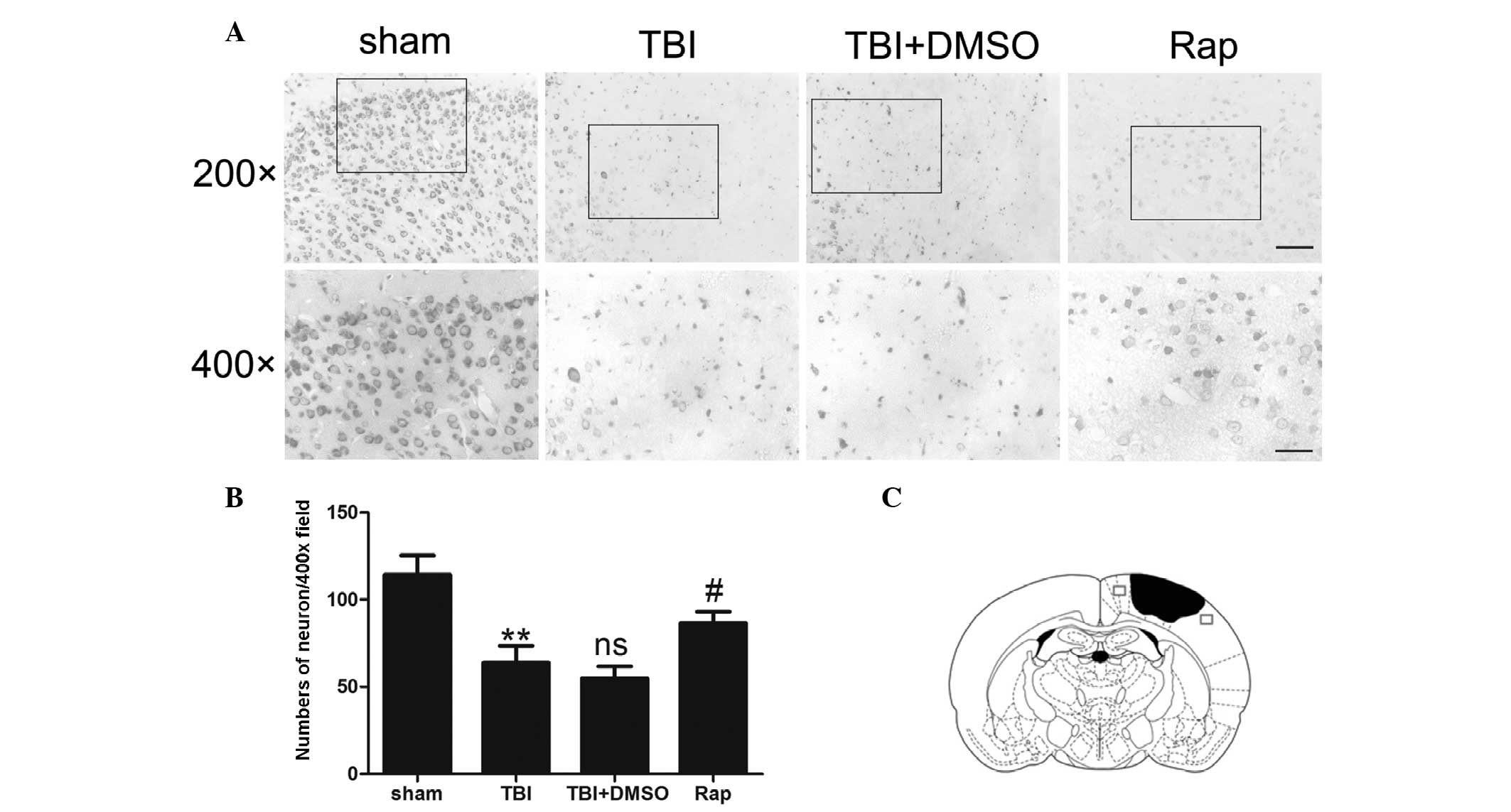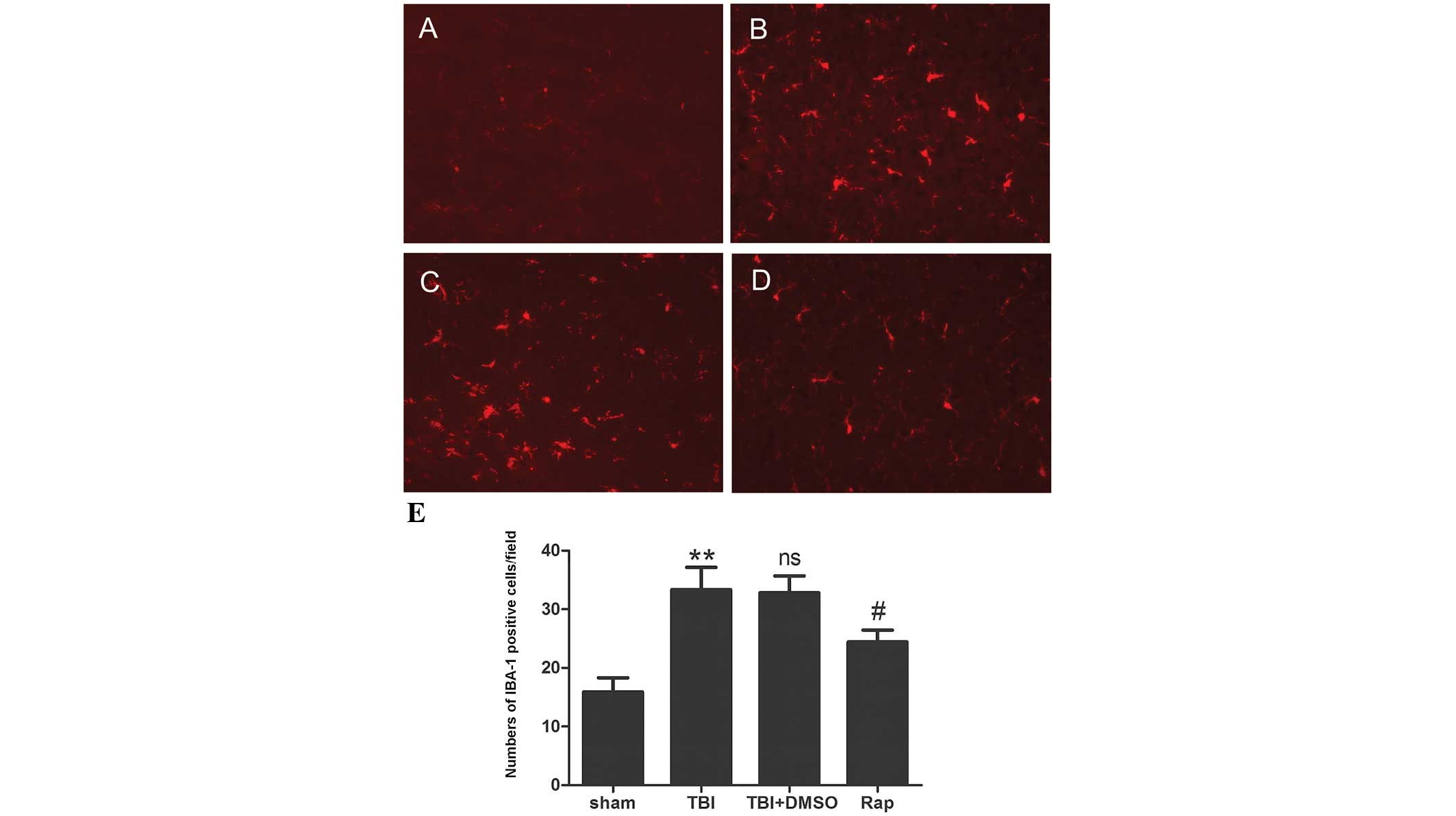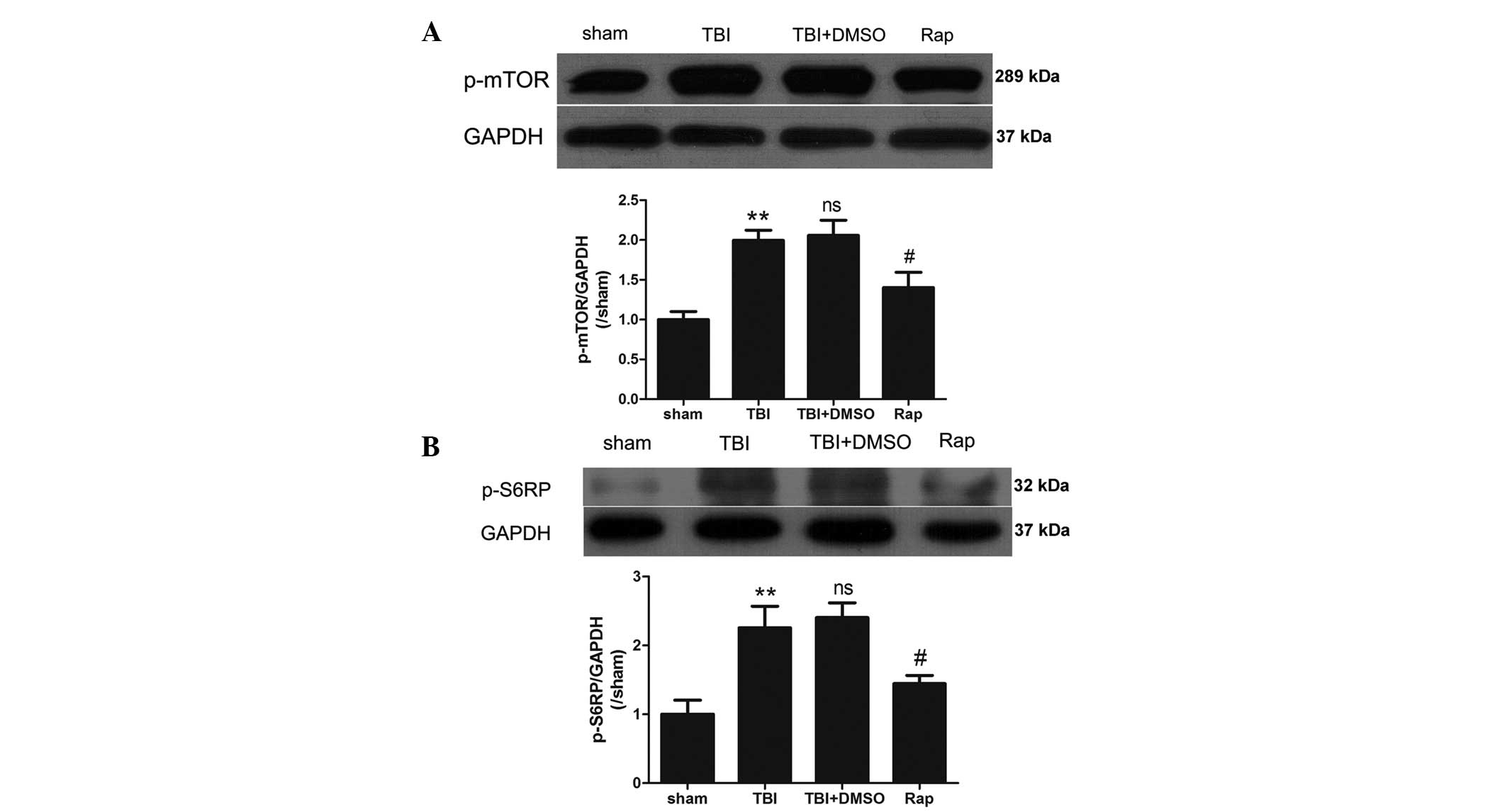|
1
|
Cernak I: Animal models of head trauma.
NeuroRx. 2:410–422. 2005. View Article : Google Scholar
|
|
2
|
Yatsiv I, Grigoriadis N, Simeonidou C, et
al: Erythropoietin is neuroprotective, improves functional recovery
and reduces neuronal apoptosis and inflammation in a rodent model
of experimental closed head injury. FASEB J. 19:1701–1703.
2005.PubMed/NCBI
|
|
3
|
Xu J, Wang H, Ding K, et al: Inhibition of
cathepsin S produces neuroprotective effects after traumatic brain
injury in mice. Mediators Inflamm. 2013:1878732013. View Article : Google Scholar : PubMed/NCBI
|
|
4
|
Cornelius C, Crupi R, Calabrese V, et al:
Traumatic brain injury: oxidative stress and neuroprotection.
Antioxid Redox Signal. 19:836–853. 2013. View Article : Google Scholar : PubMed/NCBI
|
|
5
|
Ziebell JM and Morganti-Kossmann MC:
Involvement of pro- and anti-inflammatory cytokines and chemokines
in the pathophysiology of traumatic brain injury.
Neurotherapeutics. 7:22–30. 2010. View Article : Google Scholar : PubMed/NCBI
|
|
6
|
Venkatesan C, Chrzaszcz M, Choi N and
Wainwright MS: Chronic upregulation of activated microglia
immunoreactive for galectin-3/Mac-2 and nerve growth factor
following diffuse axonal injury. J Neuroinflammation. 7:322010.
View Article : Google Scholar : PubMed/NCBI
|
|
7
|
Cao T, Thomas TC, Ziebell JM, Pauly JR and
Lifshitz J: Morphological and genetic activation of microglia after
diffuse traumatic brain injury in the rat. Neuroscience. 225:65–75.
2012. View Article : Google Scholar : PubMed/NCBI
|
|
8
|
Kelley BJ, Lifshitz J and Povlishock JT:
Neuroinflammatory responses after experimental diffuse traumatic
brain injury. J Neuropathol Exp Neurol. 66:989–1001. 2007.
View Article : Google Scholar : PubMed/NCBI
|
|
9
|
Zhang R, Liu Y, Yan K, et al:
Anti-inflammatory and immunomodulatory mechanisms of mesenchymal
stem cell transplantation in experimental traumatic brain injury. J
Neuroinflammation. 10:1062013. View Article : Google Scholar : PubMed/NCBI
|
|
10
|
Ng SY, Semple BD, Morganti-Kossmann MC and
Bye N: Attenuation of microglial activation with minocycline is not
associated with changes in neurogenesis after focal traumatic brain
injury in adult mice. J Neurotrauma. 29:1410–1425. 2012. View Article : Google Scholar : PubMed/NCBI
|
|
11
|
D'Avila JC, Lam TI, Bingham D, et al:
Microglial activation induced by brain trauma is suppressed by
post-injury treatment with a PARP inhibitor. J Neuroinflammation.
9:312012. View Article : Google Scholar : PubMed/NCBI
|
|
12
|
Dazert E and Hall MN: mTOR signaling in
disease. Curr Opin Cell Biol. 23:744–755. 2011. View Article : Google Scholar : PubMed/NCBI
|
|
13
|
Reynolds TH IV, Bodine SC and Lawrence JC
Jr: Control of Ser2448 phosphorylation in the mammalian target of
rapamycin by insulin and skeletal muscle load. J Biol Chem.
277:17657–17662. 2002. View Article : Google Scholar : PubMed/NCBI
|
|
14
|
Chong ZZ, Shang YC, Zhang L, Wang S and
Maiese K: Mammalian target of rapamycin: hitting the bull's-eye for
neurological disorders. Oxid Med Cell Longev. 3:374–391. 2010.
View Article : Google Scholar
|
|
15
|
Park J, Zhang J, Qiu J, et al: Combination
therapy targeting Akt and mammalian target of rapamycin improves
functional outcome after controlled cortical impact in mice. J
Cereb Blood Flow Metab. 32:330–340. 2012. View Article : Google Scholar :
|
|
16
|
Fan W, Cheng K, Qin X, et al: mTORC1 and
mTORC2 play different roles in the functional survival of
transplanted adipose-derived stromal cells in hind limb ischemic
mice via regulating inflammation in vivo. Stem Cells. 31:203–214.
2013. View Article : Google Scholar
|
|
17
|
Vignot S, Faivre S, Aguirre D and Raymond
E: mTOR-targeted therapy of cancer with rapamycin derivatives. Ann
Oncol. 16:525–537. 2005. View Article : Google Scholar : PubMed/NCBI
|
|
18
|
Hosoi H, Dilling MB, Shikata T, et al:
Rapamycin causes poorly reversible inhibition of mTOR and induces
p53-independent apoptosis in human rhabdomyosarcoma cells. Cancer
Res. 59:886–894. 1999.PubMed/NCBI
|
|
19
|
Erlich S, Alexandrovich A, Shohami E and
Pinkas-Kramarski R: Rapamycin is a neuroprotective treatment for
traumatic brain injury. Neurobiol Dis. 26:86–93. 2007. View Article : Google Scholar : PubMed/NCBI
|
|
20
|
Flierl MA, Stahel PF, Beauchamp KM, Morgan
SJ, Smith WR and Shohami E: Mouse closed head injury model induced
by a weight-drop device. Nat Protoc. 4:1328–1337. 2009. View Article : Google Scholar : PubMed/NCBI
|
|
21
|
Ding K, Wang H, Wu Y, Zhang L, Xu J, Li T,
Ding Y, Zhu L and He J: Rapamycin protects against apoptotic
neuronal death and improves neurologic function after traumatic
brain injury in mice via modulation of the mTOR-p53-Bax axis. J
Surg Res. 194:239–247. 2015. View Article : Google Scholar
|
|
22
|
Wang J and Doré S: Heme oxygenase-1
exacerbates early brain injury after intracerebral haemorrhage.
Brain. 130:1643–1652. 2007. View Article : Google Scholar : PubMed/NCBI
|
|
23
|
Zhuang Z, Zhou Ml, You WC, et al:
Hydrogen-rich saline alleviates early brain injury via reducing
oxidative stress and brain edema following experimental
subarachnoid hemorrhage in rabbits. BMC Neurosci. 13:472012.
View Article : Google Scholar : PubMed/NCBI
|
|
24
|
Bermpohl D, You Z, Korsmeyer SJ, Moskowitz
MA and Whalen MJ: Traumatic brain injury in mice deficient in Bid:
effects on histopathology and functional outcome. J Cereb Blood
Flow Metab. 26:625–633. 2006. View Article : Google Scholar : PubMed/NCBI
|
|
25
|
Kumar A and Loane DJ: Neuroinflammation
after traumatic brain injury: opportunities for therapeutic
intervention. Brain Behav Immun. 26:1191–1201. 2012. View Article : Google Scholar : PubMed/NCBI
|
|
26
|
Lu J, Goh SJ, Tng PY, Deng YY, Ling EA and
Moochhala S: Systemic inflammatory response following acute
traumatic brain injury. Front Biosci (Landmark Ed). 14:3795–3813.
2009. View Article : Google Scholar
|
|
27
|
Rothwell NJ: Annual review prize lecture
cytokines-killers in the brain? J Physiol. 514:3–17. 1999.
View Article : Google Scholar
|
|
28
|
Ramilo O, Saez-Llorens X, Mertsola J, et
al: Tumor necrosis factor alpha/cachectin and interleukin 1 beta
initiate meningeal inflammation. J Exp Med. 172:497–507. 1990.
View Article : Google Scholar : PubMed/NCBI
|
|
29
|
Kim KS, Wass CA, Cross AS and Opal SM:
Modulation of blood-brain barrier permeability by tumor necrosis
factor and antibody to tumor necrosis factor in the rat. Lymphokine
Cytokine Res. 11:293–298. 1992.PubMed/NCBI
|
|
30
|
Smith RM and Giannoudis PV: Trauma and the
immune response. J R Soc Med. 91:417–420. 1998.PubMed/NCBI
|
|
31
|
Hesse DG, Tracey KJ, Fong Y, et al:
Cytokine appearance in human endotoxemia and primate bacteremia.
Surg Gynecol Obstet. 166:147–153. 1988.PubMed/NCBI
|
|
32
|
Winter CD, Iannotti F, Pringle AK, Trikkas
C, Clough GF and Church MK: A microdialysis method for the recovery
of IL-1beta, IL-6 and nerve growth factor from human brain in vivo.
J Neurosci Methods. 119:45–50. 2002. View Article : Google Scholar : PubMed/NCBI
|
|
33
|
Loddick SA and Rothwell NJ:
Neuroprotective effects of human recombinant interleukin-1 receptor
antagonist in focal cerebral ischaemia in the rat. J Cereb Blood
Flow Metab. 16:932–940. 1996. View Article : Google Scholar : PubMed/NCBI
|
|
34
|
Morganti-Kossmann MC, Satgunaseelan L, Bye
N and Kossmann T: Modulation of immune response by head injury.
Injury. 38:1392–1400. 2007. View Article : Google Scholar : PubMed/NCBI
|
|
35
|
Min KJ, Jou I and Joe E:
Plasminogen-induced IL-1beta and TNF-alpha production in microglia
is regulated by reactive oxygen species. Biochem Biophys Res
Commun. 312:969–974. 2003. View Article : Google Scholar : PubMed/NCBI
|
|
36
|
Dean JM, Wang X, Kaindl AM, et al:
Microglial MyD88 signaling regulates acute neuronal toxicity of
LPS-stimulated microglia in vitro. Brain Behav Immun. 24:776–783.
2010. View Article : Google Scholar
|
|
37
|
Pinteaux-Jones F, Sevastou IG, Fry VA,
Heales S, Baker D and Pocock JM: Myelin-induced microglial
neurotoxicity can be controlled by microglial metabotropic
glutamate receptors. J Neurochem. 106:442–454. 2008. View Article : Google Scholar : PubMed/NCBI
|
|
38
|
Pais TF, Figueiredo C, Peixoto R, Braz MH
and Chatterjee S: Necrotic neurons enhance microglial neurotoxicity
through induction of glutaminase by a MyD88-dependent pathway. J
Neuroinflammation. 5:432008. View Article : Google Scholar : PubMed/NCBI
|
|
39
|
Dello RC, Lisi L, Feinstein DL and Navarra
P: mTOR kinase, a key player in the regulation of glial functions:
relevance for the therapy of multiple sclerosis. Glia. 61:301–311.
2013. View Article : Google Scholar
|
|
40
|
Dello Russo C, Lisi L, Tringali G and
Navarra P: Involvement of mTOR kinase in cytokine-dependent
microglial activation and cell proliferation. Biochem Pharmacol.
78:1242–1251. 2009. View Article : Google Scholar : PubMed/NCBI
|
|
41
|
Wong M: Mammalian target of rapamycin
(mTOR) pathways in neurological diseases. Biomed J. 36:40–50. 2013.
View Article : Google Scholar : PubMed/NCBI
|
|
42
|
Fingar DC, Salama S, Tsou C, Harlow E and
Blenis J: Mammalian cell size is controlled by mTOR and its
downstream targets S6K1 and 4EBP1/eIF4E. Genes Dev. 16:1472–1487.
2002. View Article : Google Scholar : PubMed/NCBI
|
|
43
|
Shima H, Pende M, Chen Y, Fumagalli S,
Thomas G and Kozma SC: Disruption of the p70(s6k)/p85(s6k) gene
reveals a small mouse phenotype and a new functional S6 kinase.
EMBO J. 17:6649–6659. 1998. View Article : Google Scholar : PubMed/NCBI
|














